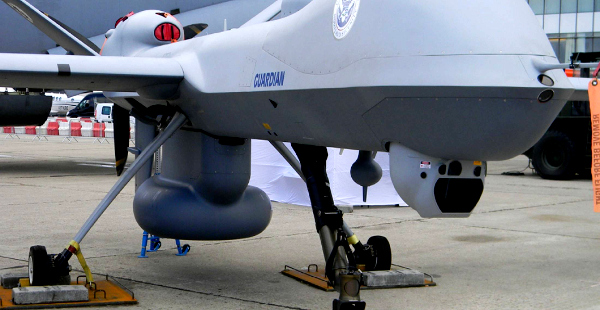The Indian Navy has leased a pair of MQ-9B SeaGuardian unmanned aerial vehicles (UAVs) from the United States to boost its intelligence, surveillance and reconnaissance capabilities, in the midst of a border row with China in the Ladakh theatre and increased Chinese activity in the Indian Ocean Region (IOR), officials familiar with developments said on Wednesday.
The two MQ-9Bs have been leased for one year, one of the officials cited above said on condition of anonymity, without disclosing the cost of the lease.
A variant of the Predator B drones manufactured by US firm General Atomics, the hi-tech maritime drones have been based at the Naval Air Station Rajali in Tamil Nadu, which is also home to the Indian Navy’s fleet of P-8I long-range maritime reconnaissance aircraft.
The MQ-9Bs will allow the navy to keep a close watch on the IOR at a time when it has stepped up surveillance and activities in the region to check China’s ambitions, a second official said.
The UAVs arrived in India in early November and began undertaking missions last week though the navy has not publicised the lease deal, the officials said.
The MQ-9B is the first piece of military hardware to be leased by India after the government announced new weapon-acquisition procedures that allowed the option of leasing weapons and systems. The Defence Acquisition Procedure-2020, which came into effect on October 1, permits the leasing of military hardware to cut down on costs associated with buying equipment.
Experts said the MQ-9Bs would boost the navy’s situational awareness over land and sea with their range and endurance. “Most drones are very useful operationally and could also be cost-effective platforms for maritime surveillance. I hope indigenous drones for such purposes are under development, but as an interim measure the MQ-9Bs could be quite critical,” said maritime affairs expert Rear Admiral Sudarshan Shrikhande (retd).
Capable of operating at an altitude of 40,000 feet, the MQ-9B UAVs have an endurance of 30 hours and a range of more than 5,000 nautical miles – capabilities that the Indian Navy will exploit fully to monitor the IOR, the officials said.
Speaking at an event on November 6, navy chief Admiral Karambir Singh
said a “great power competition” was playing out “fairly vigorously” in the IOR. “The IOR is one of the most militarised regions… Also, there are differing interpretations of international laws and there is this fear that ‘Global Commons’ can change to ‘Contested Seas’, threatening free flow of commerce and trade,” he said.
India is keeping tabs on China’s aggressive moves in the South China Sea and taking steps to ensure that the Chinese navy doesn’t muscle its way into the Indian Ocean where combat-ready Indian warships are carrying out round-the-clock surveillance for any unusual activity.
India plans to induct a total of 30 such UAVs, including armed versions, for the three services for a whopping $4 billion.
According to General Atomics, the MQ-9B can operate in adverse weather conditions because of “improved structural fatigue and damage tolerance and more robust flight control software.”
The navy currently operates a mix of Israeli-built Heron and Searcher UAVs for intelligence-gathering and surveillance. It has a vast area of responsibility in the IOR spanning millions of square kilometres, with warships deployed from as far as the Persian Gulf to the Strait of Malacca and northern Bay of Bengal to the southeast coast of Africa.
India’s exclusive economic zone alone measures 2.4 million square kilometres, which is also the navy’s responsibility.
Source: HT
You may also like
-
IAF Aircraft Set Course For Exercise Eastern Bridge VII At Oman
-
IAF Set To Host The Indian Defence Aviation Exposition-II At Jodhpur
-
Defence Secretary to co-chair 5th India-Philippines Joint Defence Cooperation Committee meeting in Manila
-
Simultaneous Launch Of ‘malpe And Mulki’, Fourth And Fifth Ships Of Asw Swc (Csl) Project
-
Aatmanirbharta in Defence: MoD signs Contract with HAL for 240 AL-31FP Aero Engines for Su-30MKI Aircraft
